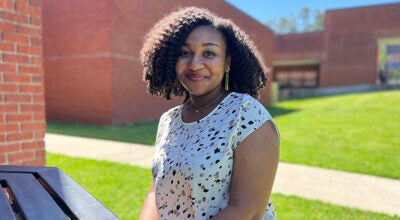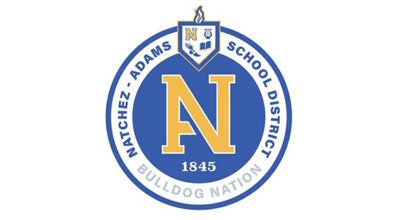Majority of area students choose virtual learning
Published 9:29 pm Friday, September 4, 2020

- Natchez High School science teacher Cardell Jenkins trains teacher remotely how to use the school system’s software that will be used to conduct virtual classes starting Wednesday. (Ben Hillyer | The Natchez Democrat)
|
Getting your Trinity Audio player ready...
|
By SCOTT HAWKINS & SABRINA ROBERTSON
NATCHEZ — Public and private schools in the Miss-Lou have had to get creative to continue serving their students in the safest way possible as schools begin fall sessions amid the COVID-19 pandemic.
Natchez Adams School District
Natchez Adams School District students begin fall classes on Wednesday and this year will be a year like no other as the state and nation continue to battle the COVID-19 pandemic.
NASD officials have offered students two options for attending classes this year to help limit the spread of COVID-19.
Students can attend a hybrid schedule that mixes three days per week of online virtual attendance and two days per week of in-person classes or students can go totally online virtual learning.
NASD officials sent out a survey to parents earlier this summer asking which option they would prefer and 80% chose the online only option, said Tony Fields, public engagement coordinator for NASD.
Hybrid learning
Under the hybrid schedule, students at each school will be divided into two cohorts — Cohort A and Cohort B. Members of Cohort A will go to school on Mondays and Wednesdays. Members of Cohort B will go to school on Tuesdays and Thursdays, Fields said.
Sharonda and Larry Hooper said they chose the hybrid schedule for their two children, London, a student at McLaurin, and Kaydan, a student at Natchez Freshman Academy, where Larry is the principal.
Sharonda said she is concerned about the possible spread of COVID-19 during in-person attendance but felt like the school had a good plan in place to mitigate the potential spread by screening people before they enter buildings and requiring people to wear masks.
Sharonda said she also liked the hybrid option because she believes fewer in-person students would give children who do attend in-person classes more of an opportunity to have one-on-one classroom instruction.
“Sometimes kids need one-on-one with them having the common core type stuff,” Sharonda said. “Sometimes the parents don’t understand it. It is a perfect opportunity for more one-on-one, in-depth learning for my child, because most people will probably choose the virtual learning.”
Sharonda, who works at Jefferson Comprehensive Health in Natchez, said she would rely on family members to help with the children when they are at home and her home has all the technology they will need for online instruction.
Online only
Fields said, based on the parents’ responses, 94% of NASD students have some form of internet connectivity.
“We suspect that the number will decrease when school activity increases,” Fields said. “The use of virtual communication tools will require high-speed, stable connections.”
To that end, NASD board members met last week in a special-called meeting and unanimously adopted an Equity in Distance Learning implementation plan for the 2020-2021 School year.
Deputy Superintendent Zandra McDonald presented the district’s plan, which is required for participation in the Mississippi Connects program, which is designed to provide every public-school student in Mississippi with the technology to learn at school and at home with $200 million allocated by the Mississippi Legislature.
Mississippi Connects covers up to 80% of costs for school districts to purchase computer devices and other tools to enable students to continue to learn when they are not in a school building. School districts must pay at least 20% of the costs for the program, Fields said.
“As a 100% Title I school district, Natchez-Adams School District will purchase devices to ensure that all students and teachers of the district will have a device for remote learning,” Fields said, adding 178 Chromebooks have been purchased independently by the district. “An additional 3,172 Chromebooks will be purchased through the Mississippi Department of Education’s Equity in Distance Learning allocations with an estimated cost of $1,404,198.”
NASD will pay 20% of that cost, and Fields said the devices have been ordered.
“We have had requests for approximately 100 devices,” Fields said. “Districts across the state are experiencing delayed shipping times. We are expecting devices to begin arriving in the district late September into October. According to MDE, devices may be delayed until as late as November.”
Fields said the district would use software called “Canvas” as its learning management system and district teachers and administrators spent time last week training to use the program and equipment. Parents will take part in training next week, Fields said.
“Other equipment will be added for distance learning to include Zoom video communication, webcams and video streaming equipment,” Fields said. “The total cost of this portion of EDLA will be $408,190.”
NASD will pay 20% of that cost.
For students who do not have internet access or who have poor internet access, the district will provide mobile hotspots.
“We have not released information regarding hotspots in order for parents to request them,” Fields said. “We are still in the process of securing 300 devices to provide our families.”
Frazier and West Elementary announced in early August their approval for the First Book Grant, Fields said. The grant will provide 350 computers and a $4,000 stipend for mobile hotspots.
“All equipment purchased will be inventoried and remain the property of The Natchez-Adams School District,” Fields said.
The mobile hotspots tap into 3G and, or 4G cellular networks, Fields said.
“Once it’s zeroed in on cellular data connection, a mobile hotspot can share that connection via Wi-Fi with nearby laptops, tablets, game consoles or anything that can connect to a Wi-Fi network,” Fields said.
To help students in the field, the district has hired three social workers to be a team that will work closely with the district’s dropout prevention coordinator and state attendance officer to support students and their families in the virtual learning environment, Fields said.
The district’s busing contractor will be used to shuttle meals and hard copies of learning materials to the students in the filed as well, Fields said.
Cathedral School
Cathedral School Lead Administrator Norm Yvon said Cathedral chose to offer only in-person classes this year with safety protocols such as mask-wearing.
“Our community did not want to go with a hybrid schedule,” Yvon said. “They wanted to be in here five days a week with everybody.”
Virtual learning is offered only to students for whom there is a medical requirement of a child or parent, Yvon said.
“The best example I can give you is if a parent is going through chemotherapy and their immune system is severely depressed and it is not a good idea for their kid to be out among anybody,” Yvon said, “that person is being offered virtual learning.”
Yvon said fewer than 10 Cathedral students are attending virtually this year and if a student needs virtual learning equipment the school would provide it.
“At this point it wasn’t necessary,” Yvon said of providing equipment for virtual learning.
Students attending virtually have the opportunity to return at the exchange of each quarter, Yvon said.
“If anything changes they can always come back and vice versa as well,” Yvon said. “If something happens during the school year and that person has a significant medical issue they can revert to distance learning.”
Adams County Christian School
Adams County Christian School Assistant Principal, Christina Daugherty said the private school has been fortunate to be able to limit class sizes without splitting students with the same teacher into different classrooms.
Some students with health concerns had the option to attend school virtually and log in to Google Classroom from home to participate in class at the same time as other students.
Those students video chat with the class and a Chromebook is seated in the classroom as if the student is there in person, Daugherty said.
“They participate, raise their hand to talk and do everything that all of the other students do,” she said. “I never would have thought that it would have been so easy to do and it works. Everything has gone really well but has definitely been something that we’ve had to get used to.”
Classroom transitions and lunch breaks have also changed since COVID-19, Daugherty said.
Students now switch classes in intervals to limit hallway traffic and take their lunch inside the classroom, she said.
All students were equipped with Chromebooks and families have to provide their own internet in the event that the school has to shut down its campus like last spring, Daughtery said.
Even in the months the school was closed, 100% of students participated in lessons from home, she said.
Concordia Parish School District
Concordia Parish School District Superintendent Whest Shirley said every student in the parish, which began fall semester on Aug. 24, has been issued a Chromebook to use at home. However, between 30% to 40% of students in the parish have internet at home currently, he said.
The remainder of students will each receive one of more than 2,700 mobile hotspot devices purchased via the CARES Act so they can have online classes, Shirley said, adding he expects all of the students in the parish to have Wi-Fi at home by October.
“The initial order has not come in yet,” Shirley said. “It could be any day now. This is a new environment not only for us but for everyone across the U.S. Fortunately, We were already one to one as far as the Chromebooks but we still needed to beef up our technology so that every student can use them at home.”
Students who participate in fully virtual classes — which is approximately half of the students in the parish — already have Wi-Fi access while hybrid students who haven’t received Wi-Fi devices yet are being supplemented with hard copy homework assignments until the shipment of mobile hotspot devices arrives, Shirley said.
“This is just a whole new dimension of education that is not be going away anytime soon,” he said. “Even after COVID if there is a snowstorm, a hurricane or another pandemic, as long as we have power we’ll still be able to educate. Our students will no longer be out of reach.”
Working parents
Working parents have also had to adapt to the changes in schools during the COVID-19 pandemic.
Allen and Becky Lipscomb have a boy and girl set of twins that started the fourth-grade on Aug. 24 at Vidalia Upper Elementary.
Seth and Allie, age 9, now spend time at their grandparents’ house on weekdays when they are at home and their parents are at work, Becky said.
“So far it has gone smoothly for us but they have grandparents that are able to keep them,” Becky said. “We make sure we know what is expected of them each day.”
Becky said her children have been given paper assignments to do at home while the schools wait on everyone to be issued a Chromebook and internet devices.
“Right now I don’t expect my parents to have to teach them,” Becky said. “Being in the fourth grade, they can pretty much handle it. As soon as we get the Chromebook, I assume it is going to require a bit more work. I’ve kept in touch with teachers and I feel fine that they are keeping the learning pathways open between us and them.”
Becky said she feels comfortable with how the schools have handled the COVID-19 pandemic.
“It has been smooth so far and I know that they are doing everything that they can to keep the classrooms safe and socially distance,” Becky said. “I’m not really concerned because I know we’re all doing our part. It was an issue at first having kids go to school and then go to their elderly grandparents’ home but I’m OK with that because I know everyone is doing right. My main goal is to make sure that by the end of fourth grade my kids get all of the education that they were supposed to get for the fourth grade.”
Delta Charter
Delta Charter school principal Jimmy Comeaux said approximately 100 students at Delta Charter are enrolled in fully virtual classes while the remainder of students are participating in face-to-face instruction on campus.
“We haven’t had any connectivity issues until Hurricane Laura hit,” Comeaux said, adding students were still out of school until Wednesday due to some not having power after the hurricane.





